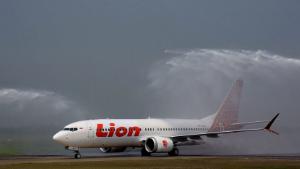WSJ: Boeing withheld info on model of plane involved in Indonesia crash
Boeing allegedly withheld information about the potential hazards of new flight-control features on the model of plane involved in the deadly Lion Air crash in Indonesia last month, according to the Wall Street Journal.
Citing "safety experts involved in the investigation, as well as midlevel FAA officials and airline pilots," the Journal reported Monday that the automated stall-prevention system on Boeing 737 MAX 8 and MAX 9 models -- intended to help cockpit crews avoid mistakenly raising a plane's nose dangerously high -- "under unusual conditions can push it down unexpectedly and so strongly that flight crews can't pull it back up."
According to the report, Boeing told airlines that such a situation "can result in a steep dive or crash -- even if pilots are manually flying the jetliner and don't expect flight-control computers to kick in."
In a statement in response to the WSJ report, Boeing did not specifically address the safety claims. "We are taking every measure to fully understand all aspects of this incident, working closely with the investigating team and all regulatory authorities involved," the company said, reiterating previous comments about the October 29 crash. "We are confident in the safety of the 737 MAX."
Lion Air: Sensor was replaced day before crash but problems persisted
"What seems to have happened here is that a new version or a modified anti-stall capacity was added which pushes the nose down automatically. If it's true, it is beyond comprehension that Boeing did not tell the airline and pilots about this," said CNN aviation correspondent Richard Quest.
He added that if the WSJ report is confirmed, the matter will be one for aviation regulators to take up, rather than individual airlines.
"The issue is how much information to give the pilots about the systems on board so they can respond in an emergency," Quest said, adding that pilots are often overloaded with readouts and signals from multiple devices and monitors that can risk distracting them at the worst possible moment.
Lion Air did not immediately respond to a request for comment about the WSJ story.
Lion Air sensor replaced
Last week, investigators working on the Lion Air Flight 610 crash -- in which 189 people died -- said a sensor on board the aircraft had been replaced the day before the incident, but problems persisted.
Indonesian authorities confirmed last Wednesday that the angle of attack (AOA) sensor was replaced after a flight from Manado, in North Sulawesi, to Denpasar, Bali, on October 28. The Boeing 737 MAX 8 then made another flight to Jakarta that same day, and the pilots reported further problems.
An AOA sensor is an instrument, similar to a small wind vane, that sits outside the plane just below the cockpit and sends information to its computers about the angle of the plane's nose relative to the oncoming air. The sensor helps to determine whether the plane is about to stall and dive.
Investigators said the jet experienced problems on its last four flights -- including, crucially, the flight that crashed, according to Soerjanto Tjahjono, the head of the National Transportation Safety Committee (KNKT).
Boeing released an operational bulletin on Wednesday, warning all airlines about how to address any erroneous readings related to the AOA sensor. The Federal Aviation Administration (FAA) later issued its own directive that advised pilots about how to respond to similar problems.

Families grieve at airport after plane crash
Search for voice recorder
Almost two weeks after the crash, authorities are still searching for the plane's cockpit voice recorder (CVR), which is believed to be buried under deep mud. If found, it should reveal what happened in the cockpit in the final seconds of the flight.
Investigators are already examining the flight data recorder (FDR) that was pulled off the sea bed, some 30 meters under water, on November 1. Preliminary findings suggested there were problems with the air speed indicator on the past three flights before the crash.
The airspeed indicator is like a speedometer and tells the pilot how fast the plane is moving through the air. It does this by gathering data from the plane's pitot tube and the static port, which essentially compare differentials in the air pressure to arrive at the plane's speed and the altitude.
After problems were reported with the air speed indicator, the AOA sensor was replaced by a Lion Air technician in Bali before the plane departed for Jakarta on its penultimate flight.
Passengers on that flight told CNN that the plane experienced a significant drop in altitude shortly after takeoff. "After 10 minutes in the air the plane dropped as if it was losing power. People panicked. It dropped about 400 feet," passenger Robbi Gaharu said.
Once in Jakarta, a Lion Air technician checked the plane again and gave it the green light to fly on its final flight, from Jakarta to Pangkal Pinang.
News Courtesy: www.cnn.com












